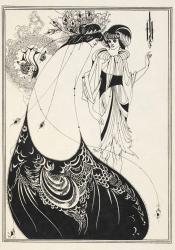Salome is Published
Salome was already in rehearsals for a 1892 London premiere, but was banned by the Lord Chamberlain's Office for its portrayal of BIblical figures on stage. In 1893, the play was published in its original French. Wilde is quoted as having said to an interviewer with the Pall Mall Gazette in 1892, "My idea of writing the play was simply this: I have one instrument that I know I can command, and that is the English language. There was another instrument to which I had listened all my life, and I wanted once to touch this new instrument to see whether I could make any beautiful thing out of it". Salome follows the step-daughter of King Herod (named Salome, if you couldn't guess). She performs a dance for King Herod, the Dance of Seven Scarves, and afterwords she requests the head of John the Bapitist on a silver platter. The main focus of the play was the dance, in which seven silk scarves work as extensions of the performers body. The sexuality of Wilde's version of Salome's dance differs greatly from that mentioned in the New Testament. This is believed to be directly linked to Huysmans writing about the story of Salome in A Rebours. Huysmans's surrealist interpretation of Salome's performance for Herod is brought to life via Wilde's script.

